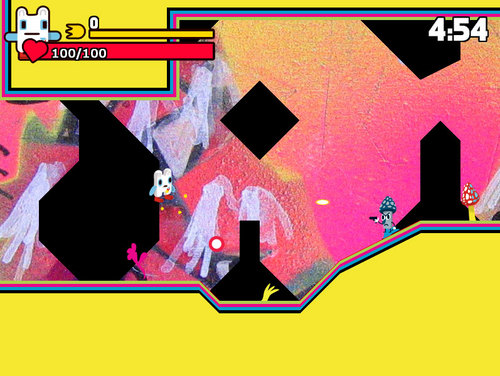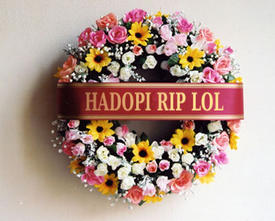The Latest from Boing Boing |  |
- Back to the Future wedding cake
- Student challenges prof, wins right to post source code he wrote for course
- Lucy Knisley's zombie invasion poster
- The Top 10 most absurd Time covers of the past 40 years
- A Monkey on My Back (non-metaphorically speaking)
- Reviving American chestnuts may mitigate climate change
- Scalin Skullpaper
- I Met the Walrus: How One Day with John Lennon Changed My Life Forever
- GOOD infographic: largest bankruptcies in history
- Dress made from meat
- France's three-strikes copyright rule is unconstitutional and hence dead
- Blog devoted to ugly logos
- No Entry sign changed to Ninja Entry sign
- Enjoy a frosty shoke
- Interview: James White of Signalnoise
- Slide-together playing card polyhedron
- Absinthe and Flamethrower Review in Today's New York Times
- The Brain that Changes Itself: hopeful book on the science of neuroplasticity
- Recently on Offworld
| Back to the Future wedding cake Posted: 11 Jun 2009 01:03 AM PDT  This fantastic courthouse-scene-from-Back -to-the-Future cake was Flickr user Snot Boogie's wedding cake: "The cake was the clock tower and was red velvet. It was done by Caryn's Cakes in Atlanta." Wedding Cake (Thanks, Jay!) Previously:
|
| Student challenges prof, wins right to post source code he wrote for course Posted: 11 Jun 2009 12:59 AM PDT Kyle Brady writes, "Thanks to some perseverance and asking the right questions, SJSU professors are now prohibited from barring students from posting their code solutions online, as well as penalizing their students for doing so. A win for students, programmers, and copyfighters nationwide!" Kyle's a student at San Jose State University who was threatened with a failing grade for posting the code he wrote for the course -- he wanted to make it available in the spirit of academic knowledge-sharing, and as code for potential future employers to review -- and when he refused, his prof flew into a fury and promised that in future, he would make a prohibition on posting your work (even after the course was finished) a condition of taking his course. Kyle appealed it to the department head, who took it up with the Office of Student Conduct and Ethical Development and the Judicial Affairs Officer of SJSU, who ruled that, "what you [Kyle] have done does not in any way constitute a violation of the University Academic Integrity Policy, and that Dr. Beeson cannot claim otherwise." There's a lot of meat on the bones of this story. The most important lesson from it for me is that students want to produce meaningful output from their course-assignments, things that have intrinsic value apart from their usefulness for assessing their progress in the course. Profs -- including me, at times -- fall into the lazy trap of wanting to assign rotework that can be endlessly recycled as work for new students, a model that fails when the students treat their work as useful in and of itself and therefore worthy of making public for their peers and other interested parties who find them through search results, links, etc. But the convenience of profs must be secondary to the pedagogical value of the university experience -- especially now, with universities ratcheting up their tuition fees and trying to justify an education that can put students into debt for the majority of their working lives. Students work harder when the work is meaningful, when it has value other than as a yardstick for measuring their comprehension. I've always thought it was miserable that we take the supposed best and brightest in society, charge them up to $60,000 a year in fees, then put them to work for four years on producing busywork that no one -- not them, not their profs, not other scholars -- actually wants to read. Might as well get them to spend four years carving detailed models of ships from sweet potatoes (and then bury the potatoes). And in this case, it's especially poignant, since Kyle's workflow actually matches the practices of real-world programmers and academic computer scientists: coders look at one anothers' examples, use reference implementations, publish their code for review by peers. If you hired a programmer who insisted that none of her co-workers could see her work, you'd immediately fire her -- that's just not how software is written. Kyle's prof's idea of how computer programmers work is exactly what's meant by the pejorative sense of "academic" -- unrealistic, hidebound, and out-of-touch with reality. Bravo to Kyle for standing his ground! How I Won a Copyfight (Thanks, Kyle!) |
| Lucy Knisley's zombie invasion poster Posted: 10 Jun 2009 03:42 PM PDT  Cartoonist Lucy Knisley drew this fabulous poster of a zombie invasion to sell at the Museum of Comic and Cartoon Arts Festival in New York. She promises to sell it online soon, too. Make sure to admire the larger version here. |
| The Top 10 most absurd Time covers of the past 40 years Posted: 10 Jun 2009 03:25 PM PDT  Radley Balko and Jeff Winkler of Reason put together a fun gallery of the "The Top 10 Most Absurd Time Covers of The Past 40 Years," with appropriate commentary. From William Randolph Hearst's ginned up hysterical stories about marijuana to the "10-cent plague" comic book scare of the 1950s to The New York Times warning of "cocaine-crazed Negroes" raping white women across the Southern countryside, the media has always whipped up anxiety and increased readership via thinly sourced exposes of the next great threat to the American way of life.The Top 10 Most Absurd Time Covers of The Past 40 Years |
| A Monkey on My Back (non-metaphorically speaking) Posted: 10 Jun 2009 12:07 PM PDT (Bill Gurstelle is guest blogging here on Boing Boing. He is the author of several books including Backyard Ballistics, and the recently published Absinthe and Flamethrowers. Twitter: @wmgurst) Writing a book is a long and difficult process. Sometimes, a part of the book that the author really likes is excised by the editor. Well, thanks to Mark and the other Boingboing'ers I get to share it here. The dens of the amphitheatre disgorged at once a hundred lions; a hundred darts from the unerring hand of Commodus laid them dead as they ran raging around the Arena. Neither the huge bulk of the elephant, nor the scaly hide of the rhinoceros, could defend them from his stroke. Ethiopia and India yielded their most extraordinary productions; and several animals were slain in the amphitheatre, which had been seen only in the representations of art, or perhaps of fancy. - The History of the Decline and Fall of the Roman Empire by Edward Gibbon, Chapter 4Fairs and amusement parks at the turn of the Twentieth Century were colorful, vibrant, and boisterous places. They offered an antidote to the strict moral codes of the period and offered exotic products and activities which curious visitors found irresistible: foot long hot dogs and salt water taffy, ferris wheels and roller coasters, and . . . kangaroo boxing. In the year 1900, the Boardwalk in Atlantic City was well known for its boxing kangaroo (whose name is sadly forgotten in the sands of time.) But by all accounts, it was a hell of a good boxer and was said by more than one spectator that it could give John L. Sullivan himself a run for his money. This was the heyday of man versus kangaroo pugilism. More recently, there are several mid-20th century diary and newspaper accounts of monkey wrestling matches at county fairs. One man wrote that he went to town one day and came across a carnival where for five dollars a person could enter a cage containing an orangutan. If the person could stay in the cage with the ape for five minutes, they got paid $100. But nobody was able to do it. "After several hours of strategy sessions and drinking beer, I devised a plan and launched off to encounter the orangutan.Much more on this subject at Notes From the Technology Underground |
| Reviving American chestnuts may mitigate climate change Posted: 10 Jun 2009 12:44 PM PDT American chestnut trees are very fast growing and produce a hard wood suitable for furniture. They're good at sequestering carbon. In the early 1900s a blight nearly wiped out chestnut trees. They've never come back. But Douglass Jacobs, an associate professor of forestry and natural resources at Purdue University, has hybridized American chestnuts with blight-resistant Chinese chestnuts. The tress are 94 percent American chestnut, yet retain the blight resistance of Chinese chestnuts. Reviving American chestnuts may mitigate climate change |
| Posted: 10 Jun 2009 10:23 AM PDT (Bill Gurstelle is guest blogging here on Boing Boing. He is the author of several books including Backyard Ballistics, and the recently published Absinthe and Flamethrowers. Twitter: @wmgurst) BoingBoing readers may already be familiar with artist Noah Scalin Skull-A-Day project from a previous post. I met Noah at the 2009 GEL conference in New York City and was immediately struck by his ability to so creatively render an idea in so many different media (vegetables, shoelaces, bed sheets, concrete construction barriers, and so on.) |
| I Met the Walrus: How One Day with John Lennon Changed My Life Forever Posted: 10 Jun 2009 09:46 AM PDT  My friend Hollis, an editor at Harper, sent me a copy of the beautifully produced, illustrated book I Met the Walrus: How One Day with John Lennon Changed My Life Forever. Jerry Levitan was 14 years old when he sneaked into John and Yoko's hotel room to interview them. They welcomed him and allowed him to conduct the interview. Forty years later, Jerry wrote a book about the experience. After hearing John was in Toronto for a "bed in," Jerry tracked him down at the King Edward Hotel and convinced the world's biggest rock star to sit down for an exclusive forty-minute interview. John talked candidly about war, politics, the scandalous Two Virgins album, and the supposed subliminal messages in his music.I Met the Walrus: How One Day with John Lennon Changed My Life Forever. |
| GOOD infographic: largest bankruptcies in history Posted: 10 Jun 2009 11:52 AM PDT  GOOD magazine's infographic reveals that recent bankruptcies dwarf Enron's collapse. That gives Jeff Skilling something to be proud of! |
| Posted: 10 Jun 2009 09:14 AM PDT  Jia Jam made a dress out of real meat. I chose salami because it's thin, keeps in one piece, and is quite cheap, and bacon because it looks very, um, meaty. I considered somehow vacuum-sealing sheets of meat with those sealers they have on the markets now, but the machines were too expensive for a one-time-only disposeable dress. I ended up using the K.I.S.S. method of construction, which involved a basic shift dress out of thick cotton. I layed the meat on top, then put clear vinyl over it and sewed tracks with clear thread. I used a wide stitch length to avoid perforating the meat to the point it might just... uh, slide down the bottom of the dress. I also blotted it all before sewing to get rid of as much grease as possible to avoid clouding the vinyl. Lastly, I made sure to bind the bottom of the dress with a strip of clear vinyl to catch drips. (I love talking about this; it's so disgusting.) The whole project took about 6 hours, and I kept it refrigerated until the party. Good times.Meat Dress |
| France's three-strikes copyright rule is unconstitutional and hence dead Posted: 10 Jun 2009 10:10 AM PDT Jeremie sez, Hadopi is dead: "three strikes" killed by highest court. (Thanks, Jeremie!) Previously:
|
| Posted: 10 Jun 2009 08:55 AM PDT |
| No Entry sign changed to Ninja Entry sign Posted: 10 Jun 2009 08:44 AM PDT |
| Posted: 10 Jun 2009 08:40 AM PDT |
| Interview: James White of Signalnoise Posted: 10 Jun 2009 08:01 AM PDT  Over at Boing Boing Gadgets, we interview James White, whose stunning background art graces the new layout. Over at Boing Boing Gadgets, we interview James White, whose stunning background art graces the new layout. |
| Slide-together playing card polyhedron Posted: 10 Jun 2009 07:35 AM PDT  This beautiful polyhedron was built by Flickr user fdecomite using George Hart's slide-together technique for making complex 3D paper shapes. |
| Absinthe and Flamethrower Review in Today's New York Times Posted: 10 Jun 2009 07:30 AM PDT (Bill Gurstelle is guest blogging here on Boing Boing. He is the author of several books including Backyard Ballistics, and the recently published Absinthe and Flamethrowers. Twitter: @wmgurst) People have good days and bad days. Today, I'm pleased to say, I am having a very good day.Forgive me for tooting my own horn, but how often does this happen to a person? For Those Who Like Danger, the Home Book of Things Not to Try at Home |
| The Brain that Changes Itself: hopeful book on the science of neuroplasticity Posted: 10 Jun 2009 06:55 AM PDT  Norman Doidge's 2006 book The Brain That Changes Itself: Stories of Personal Triumph from the Frontiers of Brain Science was rightly celebrated on its initial release, and remains fascinating today. It's a chronicle of the checkered history of the theory of lifelong brain plasticity, an on-again/off-again theory that the brain's deepest, most specialized structures can be rewired to accomplish new tasks and to view the world in new ways, all through our lives. Norman Doidge's 2006 book The Brain That Changes Itself: Stories of Personal Triumph from the Frontiers of Brain Science was rightly celebrated on its initial release, and remains fascinating today. It's a chronicle of the checkered history of the theory of lifelong brain plasticity, an on-again/off-again theory that the brain's deepest, most specialized structures can be rewired to accomplish new tasks and to view the world in new ways, all through our lives. Brain plasticity exists in counterpoint to "localizationism," the theory that the brain is innately divided into functional centers -- the "speech center," the "vision center" -- and that these centers are hardwired to do one thing. It also exists in counterpoint to the idea that what plasticity the brain has, it loses in adult life, so that we become innately more set in our ways as we age. Doidge, a medical doctor and psychoanalyst, puts forth a good case for the notion that our brain's propensity for wiring in certain ways is only that, a propensity, one that can be overcome by circumstance, force of will, training and injury, for better or for worse. Working like a biographer, Doidge gives us compelling personal histories of patients and doctors who've demonstrated the remarkable plasticity of the brain, right up to a woman who was literally born with one entire side of her brain missing, who nevertheless walks, talks, thinks, votes, holds down a job and so on -- having plastically retasked her remaining half-brain into taking on the tasks more generally assigned to the missing hemisphere. Doidge's case histories are remarkable in that they demonstrate the spectrum of rewiring that the brain is capable of -- and the spectrum of difficulty associated with different kinds of rewiring. A patient whose balance-determining organs are burned out by a medication overdose, who has spent years falling, hurting herself, sick and depressed, learns to use a prosthetic that transmits positional data to her tongue in mere minutes, trains for hours, and receives days' worth of benefits, eventually recovering her life. On the other hand, stroke victims who've lost the regions of their brains that controlled certain parts of their bodies or certain kinds of thoughts have to train intensively, in a gruelling regime that demands everything they have, but they, too, stage remarkable recoveries in very short time. From autism to ADD, Doidge's heavily footnoted tour through the cutting-edge of neuroplastic research, therapies and theories inspires on every page, with the message that you can think yourself different -- change the patterns of association, change the underlying physical substrate in your head. Your limitations can be smashed, your talents honed to new heights. An appendix called "The Culturally Modified Brain," even goes some way to discussing the way that our cultural outlooks (long acknowledged to having been shaped by our brains) can also shape our brains -- changing not just how we interpret our sensory data, but the limits and capacity of the neuronal structures that process sensory data. Ultimately, this is one of the most hopeful and fascinating popular science books I've read, a book showing how science underpins the idea of positive thinking as a force for good. The Brain That Changes Itself: Stories of Personal Triumph from the Frontiers of Brain Science |
| Posted: 10 Jun 2009 08:40 AM PDT  Recently on Offworld we got the exclusive drop on Jottobots -- the next 'artxgame' from culture shops/gallery Giant Robot and Attract Mode -- which this time brings longtime Offworld favorite illustrator, artist, and They Might Be Giants collaborator J.otto Seibold together with indie dev and Snapshot producer Kyle Pulver. Their game is going on display this Saturday, the 13th at LA's GR2 gallery: head over to the post for all the details. Elsewhere we saw two more developments for budding indie devs: submissions open for Tokyo Game Show's mini-indie-showcase Sense of Wonder Night, and Collabs, a new subsection of game portal Kongregate that hopes to bring artists and musicians together with developers for future collaboration. We also saw beautiful(-ly nauseating) new screenshots of Valve's Left 4 Dead 2, and the first look at Sin and Punishment 2, the Wii followup to the basically legendary import N64 game from cult favorite dev Treasure, listened to resolutely 1-bit bleeps from Poland's Mister Beep, found a new Tetris construction T-shirt, and got what amounts to a heart-meltingly adorable Shadow of the Colossus/LittleBigPlanet crossover costumes, complete with tiny plush Wander hanging off the arm of an already downsized Colossus. And the day's 'one shot's: Harmonix re-create Abbey Road in plastic at E3, and one artist's attempt at creating box art for the wholly downloadable Art Style games. Recently on Offworld we got the exclusive drop on Jottobots -- the next 'artxgame' from culture shops/gallery Giant Robot and Attract Mode -- which this time brings longtime Offworld favorite illustrator, artist, and They Might Be Giants collaborator J.otto Seibold together with indie dev and Snapshot producer Kyle Pulver. Their game is going on display this Saturday, the 13th at LA's GR2 gallery: head over to the post for all the details. Elsewhere we saw two more developments for budding indie devs: submissions open for Tokyo Game Show's mini-indie-showcase Sense of Wonder Night, and Collabs, a new subsection of game portal Kongregate that hopes to bring artists and musicians together with developers for future collaboration. We also saw beautiful(-ly nauseating) new screenshots of Valve's Left 4 Dead 2, and the first look at Sin and Punishment 2, the Wii followup to the basically legendary import N64 game from cult favorite dev Treasure, listened to resolutely 1-bit bleeps from Poland's Mister Beep, found a new Tetris construction T-shirt, and got what amounts to a heart-meltingly adorable Shadow of the Colossus/LittleBigPlanet crossover costumes, complete with tiny plush Wander hanging off the arm of an already downsized Colossus. And the day's 'one shot's: Harmonix re-create Abbey Road in plastic at E3, and one artist's attempt at creating box art for the wholly downloadable Art Style games. |
| You are subscribed to email updates from Boing Boing To stop receiving these emails, you may unsubscribe now. | Email delivery powered by Google |
Inbox too full?  | |
| If you prefer to unsubscribe via postal mail, write to: Boing Boing, c/o Google, 20 W Kinzie, Chicago IL USA 60610 | |
 (Photo by Nicole Jacobs)
(Photo by Nicole Jacobs) 
 The Constitutionnal Council, highest jurisdiction in France gave its decision1 concerning the HADOPI "three strikes" law [ed: France's insane plan to force ISPs to cut Internet service to people who have unsubstantiated accusations of copyright infringment], final stage before the promulgation of the law. It decided that presumption of innocence is more important than the idiotic schemes from the entertainment industries to artificially prolong their obsolete models.
The Constitutionnal Council, highest jurisdiction in France gave its decision1 concerning the HADOPI "three strikes" law [ed: France's insane plan to force ISPs to cut Internet service to people who have unsubstantiated accusations of copyright infringment], final stage before the promulgation of the law. It decided that presumption of innocence is more important than the idiotic schemes from the entertainment industries to artificially prolong their obsolete models. 


No comments:
Post a Comment